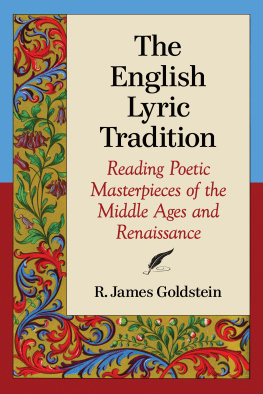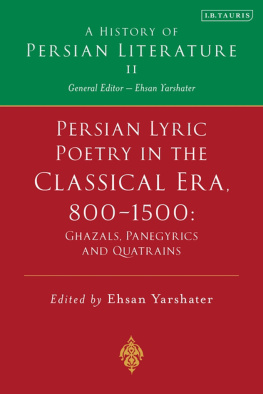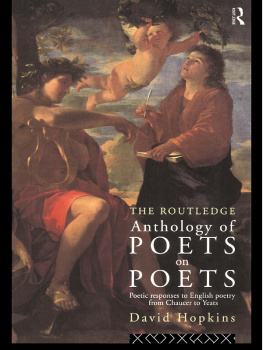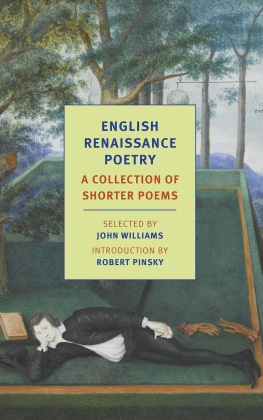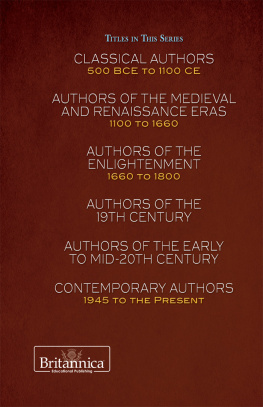
The English Lyric Tradition
Reading Poetic Masterpieces of the Middle Ages and Renaissance
R. James Goldstein

McFarland & Company, Inc., Publishers
Jefferson, North Carolina
LIBRARY OF CONGRESS CATALOGUING DATA ARE AVAILABLE
BRITISH LIBRARY CATALOGUING DATA ARE AVAILABLE
e-ISBN: 978-1-4766-2756-4
2017 R. James Goldstein. All rights reserved
No part of this book may be reproduced or transmitted in any form or by any means, electronic or mechanical, including photocopying or recording, or by any information storage and retrieval system, without permission in writing from the publisher.
Front cover images: Medieval illustration 2016 Duncan Walker/iStock; feather pen 2017 Big_Ryan/iStock
McFarland & Company, Inc., Publishers
Box 611, Jefferson, North Carolina 28640
www.mcfarlandpub.com
For Barbara
Acknowledgments
This book has been long in the making, and it is my pleasure to acknowledge the many people and institutions who helped make it possible. My oldest debt in matters poetical is to the late Anthony Hecht, whose course on the Lyric in English at the University of Rochester in 1974 first introduced me to many of the poems discussed in this book, and whose resonant voice helped teach me to listen to the sound of poetry. I am indebted to Alastair Fowler, who first introduced me to the theory of historical genres and expanded my poetic horizons in a graduate seminar on Renaissance poetry at the University of Virginia in 1979.
I am grateful to my department chair, Jeremy Downes, for his continued support, and to George Crandell, my former department head at Auburn University, for making possible a research leave in Spring 2009, when I began work on the book in earnest. I am also grateful to present and former colleagues in the Department of English for awarding me the privilege of holding the Hargis Professorship in English Literature from 2008 to 2013; without the reduced teaching load that came with this honor, my progress would have been slower. I wish to thank Anne Gramberg and Joseph Aistrup, the former and current dean of the College of Liberal Arts, for their support of the departments research mission. I also wish to thank the staff of the Ralph B. Draughon Library, Auburn University, especially Jaena Alabi, for help in obtaining materials. Three M.A. students served as my research assistants at the earlier stages of the project: Katharine Brown, Eric Anderson, and Christina Hildebrand; to each, my thanks.
I should thank the intrepid undergraduate students in my special topics course on the History of Lyric in Fall 2006, especially Douglas Anderson and Tawnysha Lynch Greene; I first conceived the idea of writing a book on early lyric poetry while teaching them. I am especially grateful to Caitlin Anderson, Paige Busby, Will Palmer, and Jeb Sharp, students in my graduate seminar on the Lyric in History and Theory in Spring 2015, for their many insights and for allowing me to try out some of my ideas on them.
For their support through the years, and especially for believing in this project, yet once more I owe a debt of gratitude to my former teachers and lifelong friends, Del Kolve and Tony Spearing. I also thank Paula Backscheider for her encouragement and advice. Friends and colleagues who read and commented on earlier drafts of one or more chapters of the book deserve to be mentioned here: Anya Riehl Bertolet, Bill Calin, Alex Dunlop, Steve Fallon, Kelly Jolley, Bobby Meyer-Lee, and Don Wehrs. I am also grateful to the two external readers for McFarland.
But my greatest debt of all is to Barbara Brumbaugh, who not only advised me on the manuscript at various stages of composition and generously shared her expertise in Renaissance literature, but also provided the emotional support I needed at every stage of the project. I dedicate this book to her: Who will in fairest book of nature know / How virtue may best lodged in beauty be, / Let him but learn of love to read in thee.
Introduction: Canonical Forms
It is no secret that of all the forms of creative writing, poetry finds the smallest audience. Although robust data for earlier periods are lacking, the number of adults who report that they read poetry seems to be in decline. Outside the classroom, the number of readers of poetry from the Renaissance or earlier, with the possible exception of Shakespeares sonnets, is very small indeed. Yet such readers do exist.
The following book is primarily addressed to students, teachers, creative writers, and educated general readers who wish to develop their ability to read early canonical forms of English poetry with greater understanding and appreciation, though I hope that professional scholars will find something of value in the book as well. For a very long time it was a central tenet of humanistic scholarship that the study of poetic masterpiecesan important part of what used to be called the literary canonis an intrinsically valuable activity. I propose to enlist poetry in precisely that humanistic cause, focusing on poems composed in English roughly between the years 1200 to 1645. I shall confine my attention to earlier lyric poetry, which for the time being may be defined as relatively short poetic compositions typically, though not invariably, voiced in the grammatical first person.
Learning to read earlier poetry in English is uniquely valuable, I suggest, in no small part because of its temporal and cultural distance from us on the one hand and the relative familiarity of its forms of linguistic invention on the other. Crafted with recognizable meter and usually with rhyme, older canonical lyric poetry has much to offer to speakers of the language, regardless of gender, ethnicity, race, nationality, class, religion, or any other markers of our social identities, although there is no denying that such differences serve as additional markers of interest and value.
It is often lamented, especially outside the academy, that the forces driving scholarly inquiry in the modern research university have led to increasingly narrow specializations. This circling of the wagons makes it difficult for scholars to communicate with others outside their own fields of expertise, much less with non-academics. Scholars in the humanities often hear complaints from the general public about the inaccessibility of their writing and the arcane nature of their research topics. The tendency toward specialization has meant that in recent decades relatively few literary scholars work across several historical periods. Although there are many books about early lyric poetry that cover much narrower periods of literary history, none devotes attention to more than a couple of centuries at most. Much more common are specialist studies that map out smaller pieces of the poetic field. By contrast, I wish to track important continuities and transformations taking place over many centuries, before the Romantic period began at the end of the eighteenth century. With Romanticism, the literary system was reorganized in ways that continue to reverberate to this day. (That so many aspiring poets today think that their chief task is to express their personal feelings is a legacy of the Romantics.)
Instead of focusing on a single lyric form like the sonnet, I include a representative range of different kinds (subgenres) of lyric poetry that are not usually placed alongside one another. My selection is designed to demonstrate how various lyric subgenres cast light on distinct areas of human concern. I believe that our lives may be further enriched by reading poetry on such topics as love, sexual desire, marriage, family, same-sex friendship, labor and employment, religious vocation, and grieving the dead. In discussing poems on these significant themes, the following study pays close attention to the craft of poetry. My focus on the historical development of poetic technique aims to help the non-specialist reader to recognize and appreciate the artistry of poems that have stood up well to the test of time.
Next page
